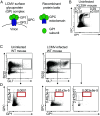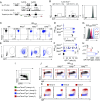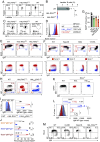Central tolerance shapes the neutralizing B cell repertoire against a persisting virus in its natural host
- PMID: 38446855
- PMCID: PMC10945855
- DOI: 10.1073/pnas.2318657121
Central tolerance shapes the neutralizing B cell repertoire against a persisting virus in its natural host
Abstract
Viral mimicry of host cell structures has been postulated to curtail the B cell receptor (BCR) repertoire against persisting viruses through tolerance mechanisms. This concept awaits, however, experimental testing in a setting of natural virus-host relationship. We engineered mouse models expressing a monoclonal BCR specific for the envelope glycoprotein of lymphocytic choriomeningitis virus (LCMV), a naturally persisting mouse pathogen. When the heavy chain of the LCMV-neutralizing antibody KL25 was paired with its unmutated ancestor light chain, most B cells underwent receptor editing, a behavior reminiscent of autoreactive clones. In contrast, monoclonal B cells expressing the same heavy chain in conjunction with the hypermutated KL25 light chain did not undergo receptor editing but exhibited low levels of surface IgM, suggesting that light chain hypermutation had lessened KL25 autoreactivity. Upon viral challenge, these IgMlow cells were not anergic but up-regulated IgM, participated in germinal center reactions, produced antiviral antibodies, and underwent immunoglobulin class switch as well as further affinity maturation. These studies on a persisting virus in its natural host species suggest that central tolerance mechanisms prune the protective antiviral B cell repertoire.
Keywords: B cell receptor editing; neutralizing antibodies; persistent viral infection; self-tolerance; viral immune evasion.
Conflict of interest statement
Competing interests statement:D.D.P. is a founder, consultant, and shareholder of Hookipa Pharma Inc. commercializing arenavirus-based vector technology, and he is listed as an inventor on corresponding patents.
Figures






References
MeSH terms
Substances
Grants and funding
LinkOut - more resources
Full Text Sources

